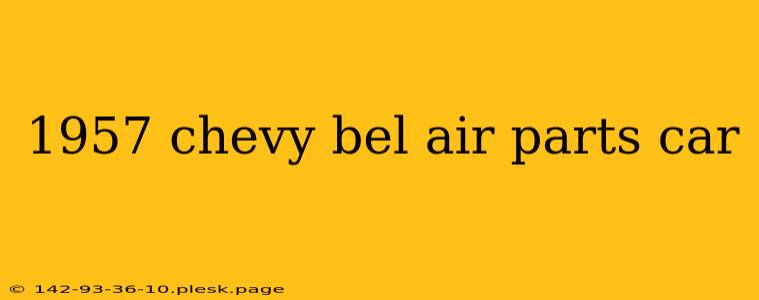Finding the right parts for your 1957 Chevy Bel Air restoration project can feel like searching for a needle in a haystack. But what if the haystack itself was a complete, albeit worn, 1957 Chevy Bel Air? That's the beauty of a parts car – a seemingly derelict vehicle that holds the key to breathing new life into your prized possession. This guide explores the world of 1957 Chevy Bel Air parts cars, highlighting what to look for, potential pitfalls, and how to maximize your investment.
Why Choose a 1957 Chevy Bel Air Parts Car?
A dedicated parts car offers several advantages over sourcing individual components:
-
Cost-Effectiveness: While the initial purchase might seem pricey, acquiring a complete car, even a damaged one, often proves cheaper than buying individual parts, especially hard-to-find items. The cumulative cost of sourcing rare trim pieces, interior components, or engine parts can quickly escalate.
-
Matching Components: Ensuring parts match the original is crucial for authenticity in a restoration. A parts car guarantees a perfect match for color, texture, and wear, eliminating the frustrating search for compatible components.
-
Complete Assemblies: Certain assemblies, like the entire dashboard or door panels, are significantly easier to salvage from a parts car than to meticulously source each individual part. This saves valuable time and effort.
-
Hidden Gems: A parts car might contain unexpected treasures – a rare option, a well-preserved interior element, or even a forgotten accessory – adding significant value to your restoration project.
What to Look for in a 1957 Chevy Bel Air Parts Car
Before making a purchase, carefully inspect the vehicle:
Body Condition:
- Rust: Assess the extent of rust damage. While some surface rust is manageable, extensive rust compromises structural integrity and reduces the usable parts. Pay close attention to the undercarriage, floor pans, and trunk.
- Collision Damage: Check for signs of significant collision damage, which might have affected the structural integrity or rendered parts unusable.
- Completeness: Prioritize cars with as many original parts as possible. Even partially complete cars often yield valuable components.
Mechanical Condition:
- Engine and Transmission: Evaluate the condition of the engine and transmission. Even if not usable in your restoration, salvageable parts might be worth the investment.
- Suspension and Brakes: Inspect the suspension and braking systems for usable components.
- Electrical System: Check the wiring harness and other electrical components.
Interior Condition:
- Upholstery and Trim: Evaluate the condition of the upholstery, door panels, and headliner. Even if damaged, these components can often be repaired or used as patterns for replacements.
Potential Pitfalls to Avoid
- Hidden Damage: Thorough inspection is paramount. Surface appearances can be deceiving; hidden damage can significantly reduce the usable parts.
- Title Issues: Ensure clear ownership and a clean title to avoid legal complications.
- Overpaying: Research comparable parts cars to establish a fair market value before making an offer.
Maximizing Your Investment
- Documentation: Take detailed photos and notes of each component. This helps to organize your parts and track what's been salvaged.
- Systematic Dismantling: Disassemble the car systematically, carefully labeling and storing parts to avoid confusion.
- Part Preservation: Properly store salvaged parts to prevent further deterioration.
Finding the right 1957 Chevy Bel Air parts car can transform your restoration journey. By carefully considering these factors and approaches, you can acquire a valuable resource that significantly contributes to your project's success while potentially saving considerable time and money. Remember, patience and thorough investigation are key to finding the perfect parts car for your classic restoration.

